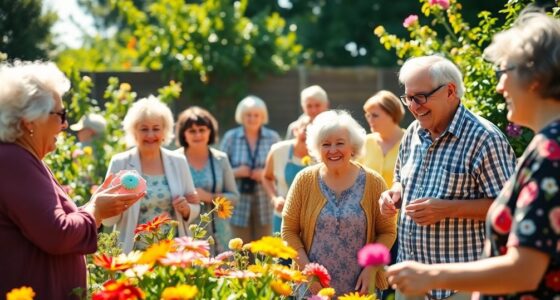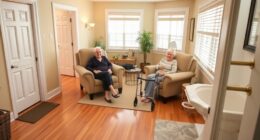To set up safe musical afternoons, choose a flat, obstacle-free space like your backyard or living room, and make sure all equipment is secure. Use even lighting and soft ambient lamps for comfort, and keep sound levels at a gentle volume with microphones to prevent strain. Arrange seating in a circle to promote inclusion and leave plenty of space for movement. Keep safety supplies handy and encourage hydration. For more tips on creating a fun, secure jam session, keep exploring.
Key Takeaways
- Choose a flat, obstacle-free space with secure equipment to prevent tripping and accidents.
- Ensure proper lighting for visibility and a cozy atmosphere, adjusting for daytime or evening sessions.
- Keep sound levels comfortable, use microphones, and test equipment to avoid hearing discomfort.
- Arrange seating in a circle or semi-circle, allowing ample space for movement and interaction.
- Have safety supplies like a first aid kit, insect repellent, and hydration options readily available.

Have you ever wondered why sing-alongs and jams bring people together? It’s that shared joy, the collective energy, and the sense of community that makes these musical gatherings so special. But to keep everyone safe and ensure the fun lasts, setting up your session properly is essential. A safe setup isn’t just about avoiding accidents; it’s about creating an environment where everyone feels comfortable to express themselves without worry.
First, choose a flat, stable space for your gathering. Whether it’s a backyard, a park, or a spacious living room, ensure the ground is even and free of obstacles. Remove any tripping hazards like cords, rocks, or clutter that could cause someone to stumble. If you’re using equipment like microphones or speakers, position them securely to prevent accidental knocks. If you’re outdoors, consider weather conditions—have a backup plan if rain or wind disrupts your setup.
Choose a flat, obstacle-free space and secure equipment for a safe, enjoyable gathering.
Lighting is another critical aspect. Adequate, even lighting makes it easier for everyone to see each other and read lyrics if needed. If your session extends into the evening, incorporate soft, ambient lights or lanterns to create a cozy atmosphere. Proper lighting also minimizes accidents, especially if your space isn’t well-lit naturally.
Sound safety should be a top priority. Keep volume levels at a comfortable level to avoid damaging hearing or disturbing neighbors. Use speakers with volume controls and test the sound beforehand to find a sweet spot where everyone can hear clearly without strain. Encourage participants to use microphones if available, so voices don’t have to strain to be heard. This not only improves sound clarity but also reduces the need for shouting, which can cause fatigue or discomfort.
Another aspect often overlooked is seating and space. Arrange chairs or blankets in a circle or semi-circle, allowing everyone to face each other. This promotes a sense of inclusion and encourages interaction. Make sure there’s enough space for movement, especially if some participants want to dance or stand up. Keep pathways clear so no one trips or blocks exits.
Finally, safety supplies like a first aid kit should be nearby, just in case. If you’re outdoors, have insect repellent and sun protection available. Remind everyone to stay hydrated and respect each other’s personal space. Being aware of your community resources can also help in case of emergencies. With these simple yet effective safety measures, your musical afternoon can be enjoyable, inclusive, and secure for everyone involved. After all, the goal is to have fun, connect, and make memories—safely.
Frequently Asked Questions
What Safety Gear Is Recommended for Outdoor Musical Gatherings?
You should wear sturdy footwear to prevent slips and falls, especially on uneven terrain. Bring sun protection like hats, sunglasses, and sunscreen to shield yourself from UV rays. Consider ear protection if you’re near loud instruments or speakers. Carry a basic first aid kit for minor injuries, and stay hydrated by drinking plenty of water. These precautions help guarantee you enjoy your outdoor musical gathering safely and comfortably.
How Do I Prevent Equipment Damage During Spontaneous Jams?
Did you know that equipment damage accounts for nearly 30% of outdoor event mishaps? To prevent this during spontaneous jams, always bring protective covers and waterproof gear for your equipment. Set up on stable, level surfaces away from moisture, and use surge protectors. Regularly check your gear for damage, and keep cables organized to avoid tripping hazards. Quick preparations like these keep your music flowing smoothly and safely.
What Are Best Practices for Managing Noise Levels?
You should monitor noise levels regularly using a decibel meter to guarantee they stay within safe limits. Keep volume levels moderate, especially in enclosed spaces, and encourage participants to be mindful of their surroundings. Use sound barriers or partitions if needed, and communicate clearly about noise expectations. Adjust equipment settings promptly if sound becomes too loud, creating a comfortable environment for everyone without risking hearing damage or disturbing neighbors.
How Can I Ensure Accessibility for All Participants?
Like a lighthouse guiding ships safely home, you can guarantee accessibility by choosing a venue with ramps and wide doorways, providing large print lyrics, and offering assistive listening devices. Speak clearly and encourage inclusive participation, making everyone feel welcome. Keep materials at easily readable levels, and be mindful of different needs. Your thoughtful preparations create a space where all voices can be heard, celebrated, and enjoyed together.
What Are Legal Considerations for Public Musical Events?
You need to secure necessary permits, check local noise ordinances, and guarantee compliance with copyright laws by obtaining licenses for any copyrighted music. Additionally, consider liability insurance and safety regulations to protect participants and organizers. Be aware of venue restrictions, health guidelines, and accessibility laws. Consulting legal experts or local authorities helps you avoid fines, legal disputes, and ensures your event runs smoothly and within legal boundaries.
Conclusion
Creating a safe setup for sing-alongs and jams keeps everyone comfortable and encourages participation. Imagine hosting a neighborhood music afternoon where you set up sturdy chairs and clear sound. When everyone feels secure, they’re more likely to join in and share their voice. By paying attention to safety and comfort, you turn a casual gathering into a memorable, joyful experience. With a little planning, your musical afternoons become safe, fun, and inclusive for all.









